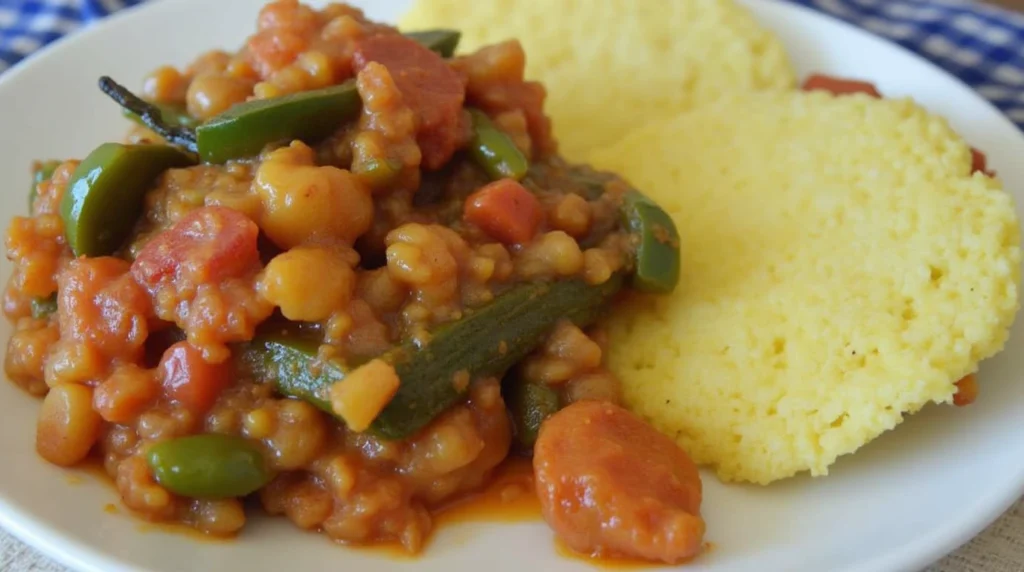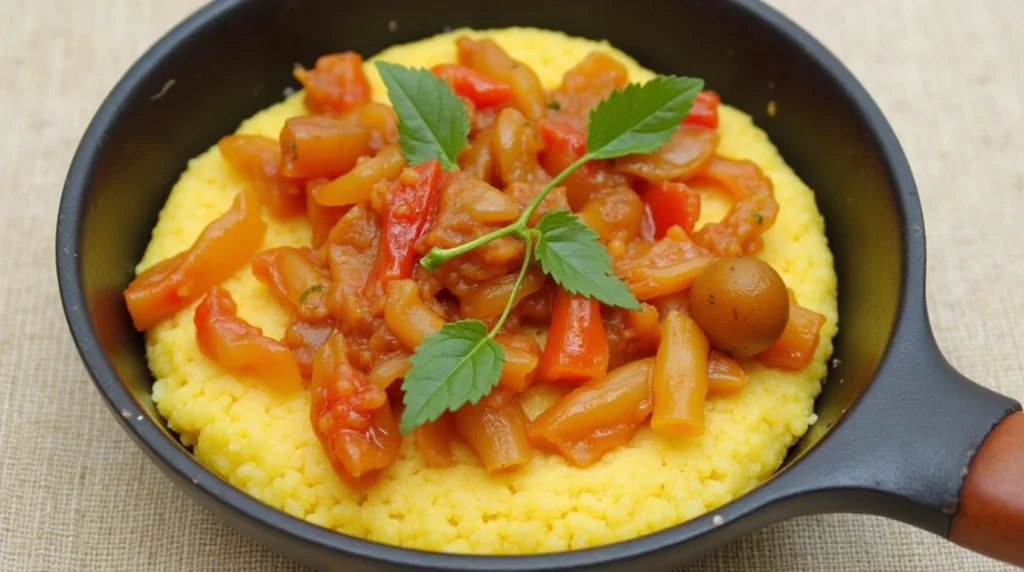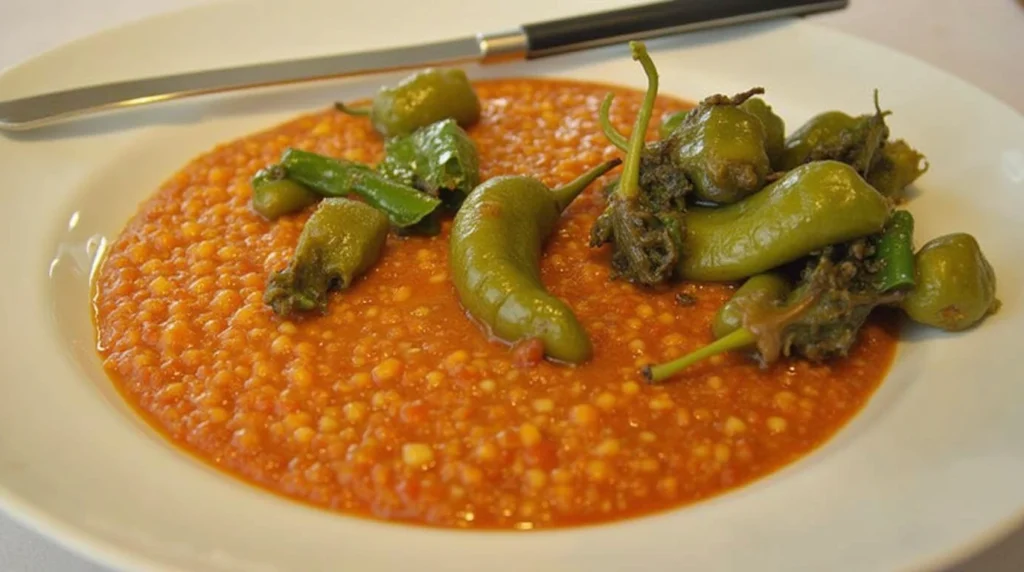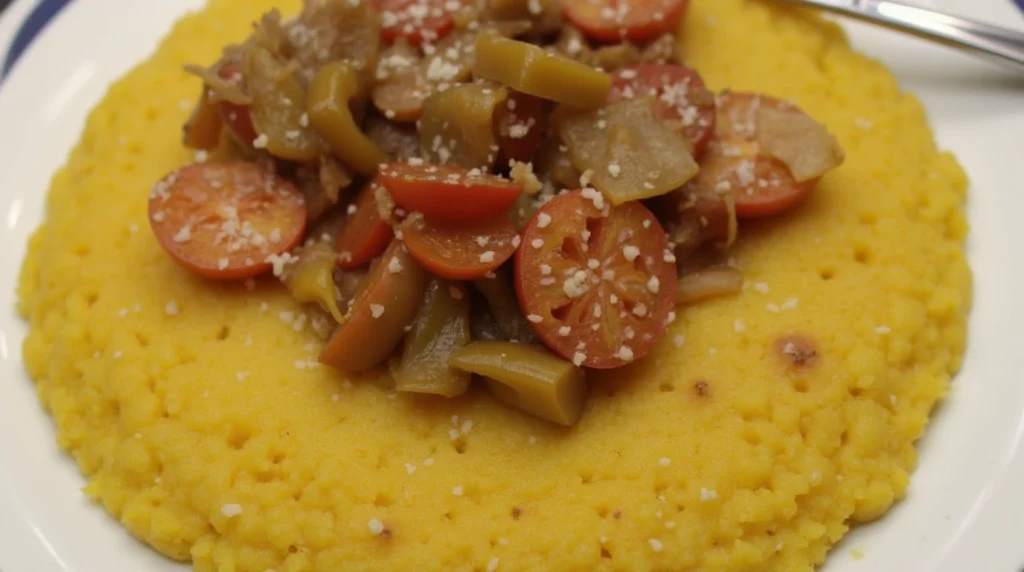Introduction

Do you remember that one meal that made you feel truly at home? For me, it was a warm bowl of polenta topped with sautéed peppers and onions. This dish isn’t just about filling your stomach—it’s about nourishing your soul. Whether you’re craving something hearty after a long day or looking to impress guests with an elegant yet simple meal, polenta with peppers and onions is here to deliver. Originating from Italian kitchens, this versatile recipe has found its way into homes worldwide, thanks to its rich flavors and adaptability. Not only does it satisfy your taste buds, but it also packs in health benefits from fresh vegetables like bell peppers and red onions. Let’s dive into how you can create this masterpiece right in your kitchen.
Understanding the Key Ingredients
To craft the perfect polenta with peppers and onions, understanding the role of each ingredient is crucial. Here’s what makes this dish so special:
Cornmeal – The Backbone of Polenta
- Cornmeal forms the foundation of polenta, available in coarse and fine grinds. Coarse cornmeal gives a rustic texture, while fine cornmeal creates a smoother consistency.
- Choose stone-ground cornmeal for better flavor and nutrition.
Bell Peppers – Adding Sweetness and Vibrancy
- Bell peppers come in various colors—red, yellow, orange, and green—and each brings unique sweetness and crunch.
- Red peppers are sweeter and riper, making them ideal for caramelizing.
Red Onions – Sharpness That Mellowed Down
- Red onions provide a sharp bite that mellows beautifully when cooked. They add depth to the dish without overpowering other flavors.
- Slice thinly for even cooking and maximum caramelization.
Olive Oil – The Essential Fat That Ties It All Together
- High-quality extra virgin olive oil enhances the richness of the dish.
- Use it generously for sautéing peppers and onions to bring out their natural sugars.
Preparing Your Polenta Base
The key to great polenta lies in its preparation. Follow these steps to achieve perfection every time:
Cooking Soft Polenta on the Stovetop
- Combine water (or broth) and salt in a pot. Bring to a boil.
- Slowly whisk in cornmeal to avoid lumps. Reduce heat to low.
- Stir frequently for 20-30 minutes until thickened.
Tips for Achieving Creamy Consistency Without Lumps
- Always add cornmeal gradually while stirring continuously.
- Consider using a wooden spoon for better control.
Adding Seasonings for Enhanced Flavor
- Incorporate dried herbs like thyme, rosemary, or oregano during cooking.
- A pinch of garlic powder adds subtle warmth.
Optional Step – Toasting Cornmeal Before Boiling
- Dry-toast cornmeal in a skillet before adding liquid for a nutty aroma.
| Polenta Base Ingredients | Quantity |
|---|---|
| Water/Broth | 4 cups |
| Cornmeal | 1 cup |
| Salt | 1 tsp |
| Olive Oil | 2 tbsp |
Sautéing Peppers and Onions
Sautéing peppers and onions is where the magic happens. Here’s how to do it right:
Techniques for Even Chopping
- Dice peppers and slice onions uniformly for consistent cooking.
- Aim for thin slices to ensure quick caramelization.
Caramelizing Onions Over High Heat
- Cook onions over medium-high heat until golden brown. Stir occasionally to prevent burning.
- Lower heat if they start browning too quickly.
Spicing Up the Mix
- Add ground paprika or chili flakes for a smoky kick.
- Freshly cracked black pepper complements the sweetness of the vegetables.
Cooking Time Tips
- Bell peppers take around 5-7 minutes to soften.
- Onions require 10-15 minutes for full caramelization.
Assembling and Serving Suggestions
Now that both components are ready, let’s bring them together:
Combining Cooked Polenta and Vegetables
- Spread hot polenta onto plates or bowls. Top generously with sautéed peppers and onions.
Topping Ideas for Extra Zest
- Sprinkle grated Parmesan cheese for creaminess.
- Garnish with chopped fresh parsley or basil for freshness.
- Drizzle balsamic glaze for a touch of tanginess.
Serving as a Side Dish or Main Course
- Serve alongside grilled meats, roasted vegetables, or creamy sauces for a balanced meal.
- Enjoy it solo as a comforting vegetarian option.
Pairing Suggestions
- Grilled chicken breast adds protein for a complete dinner.
- Roasted mushrooms pair beautifully with earthy flavors.

Variations and Creative Ideas
Don’t be afraid to experiment with this classic dish! Here are some ideas to inspire you:
Vegan Polenta Recipe
- Replace dairy products with plant-based alternatives like nutritional yeast or vegan cheese.
Adding Other Ingredients
- Zucchini, spinach, or cherry tomatoes elevate the nutrient profile.
- Crushed tomatoes or marinara sauce add acidity and depth.
Baking Polenta Squares
- Pour cooked polenta into a baking dish and chill until firm. Cut into squares and bake for crispy edges.
Gourmet Twists
- Truffle oil lends an indulgent aroma.
- Pesto adds vibrant color and flavor.
The History and Cultural Significance of Polenta
Before diving deeper into cooking techniques, let’s take a moment to appreciate the rich history behind polenta.
Origins in Ancient Italy
Polenta traces its roots back to ancient Roman times when coarse grains like millet and spelt were boiled into porridge-like dishes. Over centuries, corn became the staple grain for polenta after being introduced to Europe from the Americas in the 16th century.
A Staple in Italian Cuisine
In regions like Lombardy and Veneto, polenta has long been a symbol of comfort and sustenance. Traditionally served alongside hearty stews or grilled meats, it remains a beloved dish across generations.
Modern Adaptations Around the World
Today, chefs worldwide experiment with polenta, incorporating global flavors and ingredients. From Mexican-inspired chili toppings to Indian spices, this versatile base adapts seamlessly to diverse cuisines.
Health Benefits of Polenta with Peppers and Onions
This dish isn’t just delicious—it’s also packed with nutritional value.
Nutrient-Rich Vegetables
- Bell Peppers : High in vitamin C, antioxidants, and fiber. They support immune health and skin vitality.
- Red Onions : Contain quercetin, a powerful anti-inflammatory compound that promotes heart health.
Whole Grain Goodness
Cornmeal provides complex carbohydrates, keeping you full longer. Opt for whole-grain varieties to boost fiber intake.
Low-Calorie, High-Satiety Meal
Polenta with peppers and onions offers a satisfying meal without excessive calories, making it perfect for weight management.
Common Mistakes to Avoid When Making Polenta
Even experienced cooks can stumble when preparing polenta. Here are some pitfalls to watch out for:
Lumpy Polenta
- Cause : Adding cornmeal too quickly or not stirring enough.
- Solution : Whisk slowly and continuously as you incorporate the cornmeal.
Undercooked Polenta
- Cause : Not cooking for the recommended time.
- Solution : Stir patiently for at least 20 minutes to achieve the right consistency.
Overcooking Vegetables
- Cause : Leaving peppers and onions on high heat for too long.
- Solution : Reduce heat once they begin softening to prevent burning.
Advanced Techniques for Mastering Polenta
For those ready to elevate their skills, here are some advanced tips:
Grilling Instead of Sautéing
Grilled peppers and onions add smoky depth to your dish. Simply toss them with olive oil, season, and char on a hot grill.
Incorporating Cheese Varieties
While Parmesan is classic, consider experimenting with other cheeses:
- Gorgonzola : Adds a tangy, creamy twist.
- Ricotta : Creates a lighter, fluffier texture when mixed into the polenta.
Using Broth Instead of Water
Cooking polenta in vegetable or chicken broth enhances its flavor profile significantly.
Storing and Reheating Polenta
Proper storage ensures leftovers retain their quality.
Refrigeration Tips
- Allow cooked polenta to cool completely before transferring it to an airtight container.
- Store in the fridge for up to three days.
Reheating Methods
- Microwave : Add a splash of water or milk and microwave in short bursts, stirring between intervals.
- Stovetop : Combine leftover polenta with warm milk or broth, whisking until smooth.

Polenta-Based Recipes Beyond Peppers and Onions
Once you’ve mastered the basics, explore these exciting recipes:
Polenta Pizza Base
Spread firm polenta onto a baking sheet, top with marinara sauce, mozzarella, and fresh basil, then bake until golden.
Savory Polenta Casserole
Layer cooked polenta with roasted vegetables, béchamel sauce, and grated cheese for a decadent bake.
Polenta Fries
Cut chilled polenta into sticks, coat with breadcrumbs, and fry or bake until crispy.
Polenta as a Cultural Bridge
Regional Variations Across Italy
While polenta is widely enjoyed throughout Italy, each region puts its unique spin on the dish. For instance:
- Veneto : Served with game meats like rabbit or duck.
- Lombardy : Paired with ossobuco (braised veal shanks) for a rich, hearty combination.
- Tuscany : Often topped with wild mushrooms or truffles for an earthy twist.
These regional adaptations highlight polenta’s adaptability and its role in preserving local culinary traditions.
Global Inspirations
Beyond Italy, polenta has inspired similar dishes worldwide:
- Southern U.S. Grits : Made from hominy instead of cornmeal, grits are often served with butter, cheese, or shrimp.
- African Fufu : A starchy side dish made from cassava or plantains, fufu shares similarities in texture and function.
- Indian Bhakri : A flatbread made from millet or sorghum flour, reflecting polenta’s ancient grain-based origins.
Exploring these parallels reveals how grains have shaped global cuisines.
The Science Behind Perfect Polenta
Understanding the science behind cooking polenta can help you achieve consistent results every time.
Starch Gelatinization
Polenta’s creamy texture comes from starch gelatinization—a process where heat causes starch granules to absorb water and swell. This transformation gives polenta its signature smoothness.
Why Cornmeal Type Matters
Coarse cornmeal retains more structure, resulting in a firmer polenta ideal for slicing and baking. Fine cornmeal dissolves more easily, producing a softer, creamier texture better suited for spoonable servings.
The Role of Salt and Seasoning
Salt enhances flavor by balancing sweetness and bitterness. Adding herbs and spices during cooking infuses the polenta with depth, making it more than just a neutral base.
Hosting Tips for Serving Polenta at Gatherings
Whether you’re preparing polenta for a casual dinner or a formal event, here are some hosting tips to impress your guests:
Presentation Ideas
- Individual Portions : Serve polenta in ramekins topped with sautéed peppers and onions for an elegant touch.
- Family-Style Platter : Spread polenta onto a large wooden board and let guests help themselves.
Timing Your Preparation
Cook the polenta base ahead of time and reheat it just before serving. Sauté the peppers and onions closer to mealtime to preserve their vibrant colors and flavors.
Accompaniments That Shine
Pair polenta with complementary dishes such as:
- Grilled sausages or bratwurst for a rustic vibe.
- Roasted root vegetables like carrots and parsnips for added nutrition.
- A crisp green salad dressed with lemon vinaigrette for balance.
Polenta for Special Diets
With growing interest in dietary restrictions, polenta offers endless possibilities for customization.
Gluten-Free Delight
As mentioned earlier, polenta is naturally gluten-free. However, always verify that your cornmeal hasn’t been cross-contaminated during processing if you’re catering to strict gluten-free diets.
Low-Carb Alternatives
For those watching their carb intake, consider substituting part of the cornmeal with almond flour or coconut flour. While this alters the texture slightly, it still delivers satisfying results.
High-Protein Additions
Boost the protein content by stirring in cooked quinoa, chickpeas, or lentils. These additions make the dish more filling and nutritious.

Troubleshooting Common Issues
Even seasoned cooks encounter challenges when working with polenta. Here’s how to troubleshoot common problems:
Polenta Too Thick or Thin
- Too Thick : Gradually add warm water or broth, whisking continuously until desired consistency is reached.
- Too Thin : Simmer uncovered to reduce excess liquid.
Burnt Bottom Layer
- Cause : Not stirring frequently enough or using too high heat.
- Solution : Use a heavy-bottomed pot and stir consistently.
Uneven Cooking
- Cause : Uneven heat distribution or overcrowding the pan when sautéing vegetables.
- Solution : Cook in batches if necessary and ensure your cookware distributes heat evenly.
Polenta Around the World
Inspired by its versatility, chefs around the globe have reimagined polenta in innovative ways. Here are a few examples:
Fusion Dishes
- Mexican Polenta Tacos : Top baked polenta squares with seasoned ground beef, avocado slices, and salsa.
- Japanese Matcha Polenta : Infuse polenta with matcha powder for a unique green tea flavor.
Sweet Applications
Although traditionally savory, polenta works beautifully in desserts:
- Polenta Cake : Combine polenta with eggs, sugar, and citrus zest for a moist, dense cake.
- Caramelized Polenta Pudding : Bake polenta with brown sugar and cream for a decadent treat.
The Joy of Experimentation
One of the most rewarding aspects of cooking polenta is the freedom to experiment. Here are some ideas to spark your creativity:
Flavor Combinations
- Citrus Zest : Stir in grated orange or lemon zest for brightness.
- Herbal Infusions : Add fresh thyme, rosemary, or sage during cooking.
Textural Contrasts
- Crunchy Toppings : Sprinkle toasted nuts or seeds over soft polenta for added texture.
- Creamy Layers : Drizzle yogurt or sour cream across the top for richness.
Seasonal Ingredients
Incorporate seasonal produce to keep your polenta recipes fresh and exciting:
- Spring: Asparagus and peas.
- Summer: Zucchini and cherry tomatoes.
- Fall: Butternut squash and apples.
- Winter: Kale and roasted sweet potatoes.
Conclusion
There’s no denying the charm of polenta with peppers and onions . Its simplicity allows room for creativity, while its comforting nature satisfies cravings effortlessly. By following this guide, you’ll master the art of crafting this delightful dish. Now it’s your turn—try the recipe, tweak it to suit your preferences, and don’t forget to share your results in the comments below. Subscribe to stay updated with more delicious recipes designed to bring joy to your table.
FAQ Section
Q1: What is the best type of cornmeal for polenta?
A: Stone-ground cornmeal retains more nutrients and flavor compared to processed varieties. Opt for coarse grind for a hearty texture or fine grind for smoothness.
Q2: Can I make polenta ahead of time?
A: Absolutely! Prepare the polenta base up to two days in advance. Reheat gently with a splash of water or milk to restore creaminess.
Q3: Is polenta with peppers and onions suitable for vegans?
A: Yes, by omitting cheese and using plant-based seasonings, this dish becomes fully vegan-friendly.
Q4: How long does it take to cook polenta with peppers and onions?
A: Approximately 30-40 minutes, depending on your method and desired consistency.
Q5: Can I freeze leftover polenta?
A: Yes, freeze cooked polenta in portions for up to three months. Thaw overnight in the refrigerator before reheating.
